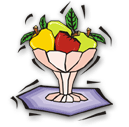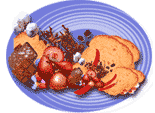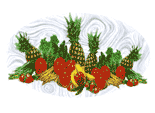 Yoga is the only science that has laid great emphasis on food over centuries. In fact, there is a whole branch – called Anna Yoga – devoted to food for health and happiness. Yoga is the only science that has laid great emphasis on food over centuries. In fact, there is a whole branch – called Anna Yoga – devoted to food for health and happiness.Yoga over centuries has developed a concept of a balanced wholefoods diet and an eating philosophy. These principles of good eating use powerful techniques which help in maintaining a strong and health body, a stress-free mind and a positive spirituality within this mixed up world. Never has this yogic philosophy of a balanced wholefoods diet been felt more than today when 97% of all health disorders can be traced to a faulty nutrition and diet. It has been observed that (East) Indian civilizations suffer least from bowel problems, constipation, indigestion and other food related disorders such as obesity. Do you know why? Because the Indian philosophy of cooking and eating draws heavily from the yogic philosophy of eating! Yoga does not dissect food into vitamins, minerals, protein etc. The yogic philosophy is that the true benefits of these ingredients can be had only when they are NOT isolated but as much in their natural form as possible. The key to true health is to have a balanced wholefoods diet. A balanced diet ensures that all the faculties of digestion work smoothly – absorption, assimilation and elimination. A balanced whole foods diet ensures a healthy you!! It is extremely important that all these 3 aspects work well together. If all these aspects work in harmony it is extremely unlikely that you’ll suffer from health disorders and even obesity. Often “synthetic” or “processed” foods create conditions that disrupt this balance. This leads to several physical and psychological problems. Over years, this can have dangerous consequences. | ||||||||||||||||||||||||||||||||||||||||||||||||||||||||||||||||||||||||||||||||||||||||||||||||||||||||||||||||||||||||||||||||||||||||||||||||||||||||||||||||||||||||||||||||||||||||||||||||||||||||||||||||||||||||||||||||||||||||||||||||||||||||||||||||||||||||||||||||||||||||||||||||||||||||||||||||||||||||||||||||||||||||||||||||||||||||||||||||||||||||||||||||||||||||||||||||||
| So what are Wholefoods? | ||||||||||||||||||||||||||||||||||||||||||||||||||||||||||||||||||||||||||||||||||||||||||||||||||||||||||||||||||||||||||||||||||||||||||||||||||||||||||||||||||||||||||||||||||||||||||||||||||||||||||||||||||||||||||||||||||||||||||||||||||||||||||||||||||||||||||||||||||||||||||||||||||||||||||||||||||||||||||||||||||||||||||||||||||||||||||||||||||||||||||||||||||||||||||||||||||
Wholefoods are edible substances which are as close to their "whole" or natural state as possible. They have not been pre-processed in any way which would disturb their nutrition or flavor. They are therefore free of all processing additives or subtractions. The overall idea of wholefoods, is to buy foods which are - * As whole and in their most simple form as possible * In season from as close to the source as possible * As chemically and additive free as possible * In bulk and not pre-packaged
| ||||||||||||||||||||||||||||||||||||||||||||||||||||||||||||||||||||||||||||||||||||||||||||||||||||||||||||||||||||||||||||||||||||||||||||||||||||||||||||||||||||||||||||||||||||||||||||||||||||||||||||||||||||||||||||||||||||||||||||||||||||||||||||||||||||||||||||||||||||||||||||||||||||||||||||||||||||||||||||||||||||||||||||||||||||||||||||||||||||||||||||||||||||||||||||||||||
skip to main |
skip to sidebar
Article List
- Yoga
- Yoga VS Gym
- yoga-relaxation-helps-to-handle-stress
- yoga-and-arthritis
- yoga-therapy
- yoga-vs-pilates
- yoga-vs-taichi
- The Health Benefits of Yoga
- Other benefits of Yoga
- Why the Yogic way for Food?
- Cleansing and Yoga
- Tips of Yoga for Weight Loss
- Yoga for the Elderly - Seniors' Way to Be Fit
- Resolved Question
- Yoga For Beauty And Healthy Skin
- Yoga and Exercise
- Is yoga better than other exercise for boosting self-esteem?
- Does Islam say anything about yoga?
- Islam Vs Yoga
- Yoga and Cancer
- Yoga can ease cancer treatment side effects
- Yoga And Heart
- Yoga Reduces Heart Disease Risk
- Effects of a Stressed Out Heart
- Yoga And Heart Diseases
- How to Do Superbrain Yoga
- SuperBrain Yoga
- About SuperBrain Yoga
- Yoga Exercise Benefits Vs. Aerobic Execise
- Yoga Improves Aerobic Capacity
- Better health benefits: yoga versus aerobics
- Yoga and Flexibility
- What are the Benefits of Hot Yoga
- What is Hot Yoga?
- 6 yoga steps to ease joint pain
- Yoga & Arthritis
- Jogging and Yoga
- Yoga for Kidney Stones | Cure for Kidney Stone
- 4 Yoga Mistakes that Can Cause Knee Pain
- Yoga and High Blood Pressure
- Yoga For Neck Pain
- The Effects of Yoga on the Nervous System
- Safe Yoga for Osteoporosis
- Yoga for Sleep
- Yoga and Swimming
- Yoga For Back Pain
- Yoga and Weight Lifting
- How to Adjust Yoga Poses for Wrist Pain
- Zen Yoga
- What is Jogging?
- Jogging Calories
- How to Start Jogging the Right Way
- The Right Way to Breathe
- How To Know the Equipment Needed for Jogging
- Important Benefits of Jogging in the Morning
- Mens Jogging Suits
- How to Maintain a Jogging Routine with Asthma
- Winter Exercise Tips for Asthmatics
- Does Jogging Help Fatigue & Anxiety?
- Exercise your way to acne free skin
- How to Get Rid of Acne Overnight
- How to Incorporate Exercise With the Atkins Diet
- The difference between running and jogging
- Jogging vs Running
- Running in the Dark
- Food Before Exercise
- Eating and exercise
- Beginning With Jogging - The Best Exercise to Burn Calories
- Men's Jogging Tips
- Jogging Tips for Women
- Switching To A Low Cholesterol Diet
- Jogging: Calories Burned Per Hour
- Running for children
- Why And How To Run Correctly
- Jogging is the best kind of sports for your health
- Jogging is useful for health and figure!
- Do you want to be for ever young?
- Jogging and medicine
- Importance of Drinking Water For Jogging
- Five Ways To Keep Hydrated While Jogging
- Jogging - The Best Cure to Depression?
- Psychological Benefits
- Jogging, Healthy and Prevent Diabetes
- 5 Smart Eating Rules for Runners
- Effects of Jogging
- Jogging for Fitness
- Gaining Weight After Jogging for a Week
- How to Control Your Heart Rate While Jogging
- Target Heart Rates
- How to Calculate Your Target Heart Rate Zone
- Cold Weather Running Safety Tips
- What Is Jogging in Place?
- Jogging in the Snow
- Tips for Running on Snow and Ice
- Tips for Running on Snow and Ice
- Jogging And Running in The Rain
- Jogging and Other Aerobic Exercising with Dogs
- Running/Jogging on the Beach
- How to Run Hills Properly
- How to Run Hill Repeats
- Benefits of Hill Running
- Jogging and Swimming the Right Way
- Jogging And Swimming - Find Out What Are The Benefits To Weight Loss
- How to Stop Smoking with Jogging
- How to Quit Smoking in Weeks
- Jogging And Swimming
- Raising Your HDL Levels
- What Are Varicose Veins?
- Is It Safe For A Varicose Veins Patient to Jogging?
- What is Cancer? What Causes Cancer?
- Treatment of Cancer?
- THE ANTI-CANCER DIET
- THE TOP ANTI-CANCER FOODS
- THE 10-STEP ANTI-CANCER PROGRAM
- EXAMINING THE LINK BETWEEN DIET AND CANCER
- HOW EXERCISE FIGHTS CANCER
- Depression Increases Cancer Patients' Risk Of Dying
- Diabetes increases cancer mortality risk
- Diabetes and Cancer: Scientists Search
- Types of Blood Cancer
- Types of Cancer Most Common in Men
- Types of Cancer in Women
- Physical Activity and Cancer
- Physical Activity and Cancer
- Exercise cuts prostate cancer death risk
- Breast Cancer
- Main Causes of Breast Cancer
- What are the main reasons for removing breast implants?
- Image of Breast Cancer
- Liver Cancer
- Main Causes Of Liver Damage
- What is Blood Cancer?
- Types of Blood Cancer
- Blood Cancer Treatment
- Oropharyngeal Cancer
- Treatment Of Oropharyngeal Cancer
- Stomach Cancer
- Treatments and drugs Of Stomach Cancer
- Eye Cancer
- Cancers in the eye
- Can eye cancer be found early?
- Can eye cancer be prevented?
- What are the risk factors for eye cancer?
- eye cancer diagnosed?
- Treatment Of Eye Cancer
- Brain Cancer
- Brain Tumor
- Prevent By Brain Tumors
- primary brain tumors
- brain tumors diagnosed and staged
- Treatments Of Brain Tumors
- Skin Caner
- Skin Cancer Symptoms
- Reason Why There is So Much Skin Cancer Today
- Chemotherapy
- How Is Skin Cancer Treated?
- Can Treatment Cure Skin Cancer?
- How Can Skin Cancer Be Prevented?
- portal vein cancer
- Diagnosis Of Portal Vein Cancer
- Treatment Of Portal Vein Cancer
- Radiation Therapy For Cancer
- Radiation Therapy For Cancer
- Throat cancer
- Causes Of Throat cancer
- Tests And Diagnosis Of Throat Cancer
- Treatments and drugs Of Throat Cancer
- Foods that Cause Cancer
- Cervical Cancer
- Risk factors and causes of cervical cancer
- Symptoms Of Cervical Cancer
- Tests And Diagnosis Of Cervical Cancer
- Treatments and drugs of Cervical Cancer
- Bone Cancer
- Causes of Bone Cancer
- Bone Cancer Symptoms and Signs
- Treatment of Bone Cancer
- Side Effects of Treatment for Bone Cancer
- Kidney cancer
- Symptoms and Causes of Kidney cancer
- Risk factors of Kidney cancer
- Tests and diagnosis of Kidney Cancer
- Treatments and drugs of Kidney Cancer
- Alternative medicine of Kidney Cancer
- Prostate Cancer
- prostate cancer causes
- Prostate Cancer Symptoms and Signs
- Screening Tests of Prostate Cancer
- How is the staging of prostate cancer done?
- Thyroid Cancer
- Thyroid Cancer Causes and Risk Factors
- Symptoms of Thyroid Cancer
- Staging Determined for Thyroid Cancer
- Treatment Of Thyroid Cancer
- Side Effects of Cancer Treatment
- Hepatitis A
- Hepatitis A Symptoms
- Seek Medical Care
- Hepatitis A Diagnosis
- Hepatitis A Treatment
- Hepatitis B
About Me
Followers
Powered by Blogger.
 A large variety of foods having different methods of preparation such as fried, highly seasoned, or baked, form this category. Alcoholic and processed beverages as well as sweets come in here.
A large variety of foods having different methods of preparation such as fried, highly seasoned, or baked, form this category. Alcoholic and processed beverages as well as sweets come in here. Foods, vegetarian or non-vegetarian, that are prepared with excess spices, salts and hot seasonings are Tamasik foods.
Foods, vegetarian or non-vegetarian, that are prepared with excess spices, salts and hot seasonings are Tamasik foods. Foods which are cooked with minimum amount of spices or seasonings and are fresh are sattvik foods. These foods retain their nutritive value as they are cooked in a very simple fashion one of the most powerful & delicious foods which have tremendous benefit on the overall system is
Foods which are cooked with minimum amount of spices or seasonings and are fresh are sattvik foods. These foods retain their nutritive value as they are cooked in a very simple fashion one of the most powerful & delicious foods which have tremendous benefit on the overall system is Print
Print




0 comments:
Post a Comment